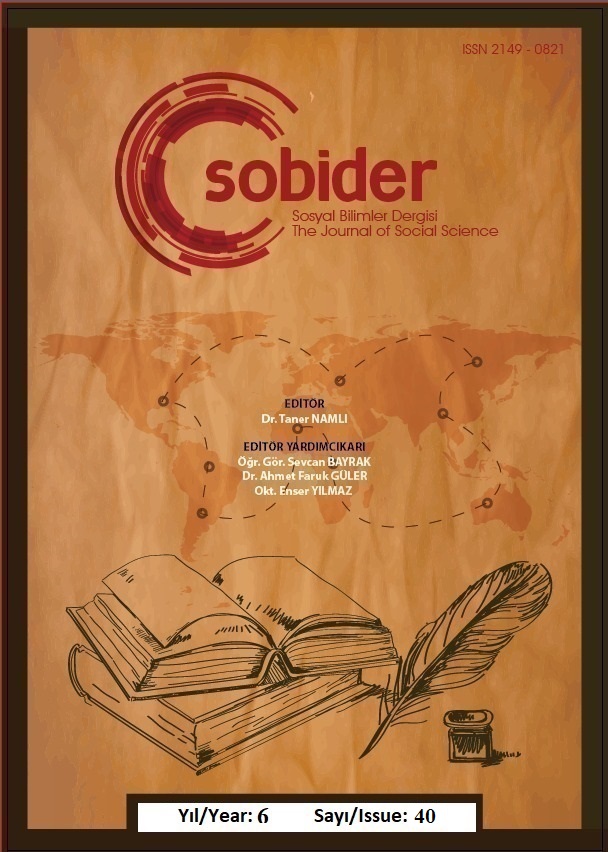Author :
Abstract
Dünya üzerindeki ülke ve ülke grupları arasında gelirin eşit dağılmaması sorunu, çözülmesi gereken konuların başında gelmektedir. Neoklasik büyüme modelinde öngörüldüğü üzere; düşük gelir düzeyine sahip ülkelerin gelirleri, zamanla yüksek gelir düzeyine sahip ülkelerin gelirlerine doğru yakınsamaktadır. Yakınsama hipotezi olarak adlandırılan bu olgunun geçerliliği, gelir dağılımı sorununun ne derecede çözüme kavuştuğu hakkında fikir vermektedir. Bu çalışmayla, G20 ülkeleri için 1999-2018 yıllarını kapsayan kişi başına düşen gelir verileri kullanılarak yakınsama hipotezi panel birim kök testi ile analiz edilmektedir. Çalışmada kullanılan veriler Dünya Bankası resmi istatistik veri tabanından elde edilmiştir. İlk olarak serilerde yatay kesit bağımlılığının olup olmadığı incelenmiştir. Yatay kesit bağımlılığı tespit edilen serilere, Pesaran (2007) tarafından geliştirilen CADF birim kök testi uygulanmıştır. Panelin geneli için serinin birim kök içerdiği yönündeki hipotez reddedilememektedir. Bu sonuç, G20 ülkeleri için yakınsamanın olmadığı yönünde kanıtlar sunmaktadır. Bireysel test sonuçlarına göre ise sadece Kanada, Endonezya ve Meksika için birim kök hipotezi reddedilmekte yani sürecin bu ülkelerde durağan olduğu sunucuna varılmaktadır. Diğer bir ifadeyle; genel sonuçları destekler nitelikte, yalnızca 3 ülke için yakınsamanın olduğu ve diğer 17 ülke için bireysel olarak yakınsama olmadığı sonucuna varılmıştır.
Keywords
Abstract
The problem of uneven distribution of income among countries and country groups in the world is one of the main issues to be solved. As predicted in the neoclassical growth model; incomes of low-income countries converge over time to the income of high-income countries. Validity of this phenomenon called convergence hypothesis, gives an idea about how the income distribution problem is solved. By this study, the convergence hypothesis is analyzed by panel unit root test for G20 countries using per capita income data covering the years 1999-2018. The data used in the study are obtained from World Bank official statistics database. Firstly, it is examined whether there is a cross-sectional dependence in the series. CADF unit root test developed by Pesaran (2007) was applied to the series which have cross-sectional dependence. For the overall panel, the hypothesis that the series contains a unit root cannot be rejected. This result provides evidence that there is no convergence for G20 countries. According to individual test results, only for Canada, Indonesia and Mexico, the unit root hypothesis is rejected, meaning that the process is stable for these countries. In other words; supporting the general results, it is concluded that there is only convergence for 3 countries and there is no individual convergence for the other 17 countries.
Keywords
- Abdioğlu, Z., & Uysal, T. (2013). Türkiye’de Bölgeler Arası Yakınsama: Panel Birim Kök Analizi. Atatürk Üniversitesi İktisadi ve İdari Bilimler Dergisi, 27(3), 125-143.
- Altın, O., Demirci, S., Çakır, O. ve Semiz, H. (2006) “AB Genişleme Sürecinin Üye Ülkelerin İktisadi Büyümesi ve Dış Ticareti Üzerine Etkileri: Panel Data Analizi”, Erişim: 15 Eylül 2006, http://www.tcmb.gov.tr.
- Bassanini, A. ve Scarpetta, S. (2001) “The Driving Forces of Economic Growth: Panel Data Evidence for the OECD Countries”, OECD Economic Studies, 33, ss.1 56.
- Bernard, A. ve Durlauf, S. (1994) “Interpreting Tests of the Convergence Hypothesis”. NBER Technical Working Papers, 159, ss.1 17.
- Caselli, F., Esquivel, G. ve Lefort, F. (1996) “Reopening the Convergence Debate: A New Look at Cross-Country Growth Empirics”, Journal of Economic Growth, 1(3), ss.363 389.
- Crespo-Cuaresma, J., Dimitz, M. A., ve Ritzberger-Grunwald, D. (2002)“Growth, Convergence and EU Membership”, National Bank of Austria Working Paper, 62, ss.1 31.
- Dahlhaus, T. (2007), Testing for Output Convergence, Unpublished master thesis.
- Dobson, S., Goddard, J. ve Ramlogan, C. (2003) “Convergence in Developing Countries: Evidence from Panel Unit Root Tests”, University of Otago Economics Discussion Papers,305, ss.1 27.
- Fleissig, A. ve Strauss, J. (2001) “Panel Unit Root Tests of OECD Stochastic Convergence”, Review of International Economics, 9(1), ss.153 162.
- Gögül, P. K., & Koralp, L. (2014). Ekonomik yakınsama olgusunun sınanması üzerine yeni bulgular: OECD örneği. Kastamonu Üniversitesi İktisadi ve İdari Bilimler Fakültesi Dergisi, 4(2), 60-73.
- Guetat, I., & Serranito, F. (2007). Income convergence within the MENA countries: A panel unit root approach. The Quarterly Review of Economics and Finance, 46(5), 685-706.
- Islam, N. (1995) “Growth Empirics: A Panel Data Approach”, Quarterly Journal of Economics, 110(4), ss.1127 1170.
- Kocenda, E. ve Papell, D. H. (1997) “Inflation Convergence within the European Union: A Panel Data Analysis, International Journal of Finance and Economics, 2(3), ss.189 98.
- Kocenda, E. (2001) “Macroeconomic Convergence in Transition Countries, Journal of Comparative Economics, 29, 1-23.
- Korap, Levent (2010), “OECD Ülkeleri için Ekonomik Yakınsama Öngörüsünün Zaman Serisi Panel Birim Kök Yöntemleri ile Sınanması”, İstanbul Ticaret Üniversitesi Sosyal Bilimler Dergisi, 9/17, 189-206.
- Kutan, A. M., ve Yigit, T. M. (2005). Real and nominal stochastic convergence: Are the new EU members ready to join the Euro zone?. Journal of Comparative Economics, 33(2), 387-400.
- Pesaran, M. H., 2004, General Diagnostic Testsfor Cross SectionDependence in Panels, CESifo Working Paper Series No. 1229; IZA Discussion Paper No. 1240.
- Pesaran, M. H. (2006). Estimation and inference in large heterogeneous panels with a multifactor error structure. Econometrica, 74(4), 967-1012.
- Pesaran, M. H. (2007). A simple panel unit root test in the presence of cross‐section dependence. Journal of Applied Econometrics, 22(2), 265-312.
- Pesaran, M. H. Ve Yamagata, T., 2008, Testing Slope Homogeneity in Large Panels, Journal of Econometrics, 142, 50–93.
- Rassekh, F., Panik, M. J., & Kolluri, B. R. (2001). A test of the convergence hypothesis: the OECD experience, 1950–1990. International Review of Economics & Finance, 10(2), 147-157.
- Sala-i Martin, X. (1996) “The Classical Approach to Convergence Analysis”, Economic Journal, 106(437), ss.1019 1036.
- Saraçoğlu, Bedriye ve Doğan, Nükhet (2005), “Avrupa Birliği Ülkeleri ve Avrupa Birliğine Aday Ülkelerin Yakınsama Analizi”, 7. Ulusal Ekonometri ve İstatistik Sempozyumuna Sunulan Tebliğ, 26-27 Mayıs, İstanbul: İstanbul Üniversitesi.
- Tatoğlu, Ferda Yerdelen (2012), Panel veri Ekonometrisi - Stata uygulamalı, Beta Basım Yayım, İstanbul.
- Tıraşoğlu, M. (2013). G20 Ülkeler İçin Gelir Yakınsama Analizinin Panel Birim Kök Testleri İle İncelenmesi. Yalova Üniversitesi Sosyal Bilimler Dergisi, 3(6).
- Yeşilyurt, F. (2014). Yakınsama Hipotezinin Oecd Ülkelerinde İkili Yaklaşımla Test Edilmesi. Sosyal Ekonomik Araştırmalar Dergisi, 14(27), 349-358.
